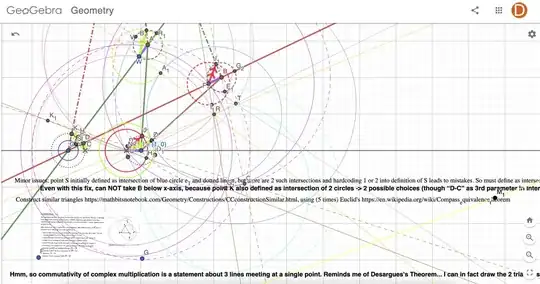It is beyond well-known that multiplication in the complex plane has a geometric interpretation, namely we can interpret multiplication by $z\in \mathbb C$ as acting on the plane by fixing $0$, and dragging the point $1$ to $z$, keeping all square grid-lines squares. One can see animations of this in this 3B1B video, for instance.
In the case of multiplying two complex numbers $a,b$, one can imagine making 2 triangle(resp. called $A,B$) with vertices at $0,1,a$ and $0,1,b$, and then $a$ "acting" on $b$ would mean scaling and rotating triangle $B$ so that the line segment originally between $0,1$ is now the line segment from $0,a$; and then where $b$ lands is the result of $a \cdot b$ "$a$ acting on $b$".
Of course, we can understand $b \cdot a$ in the same manner, but now the picture produced is changed, and I don't find it obvious geometrically that the result of $a\cdot b$ and $b\cdot a$ should be exactly the same.
I messed around a little, and the problem is pretty easy if we understand the multiplication actions separately in terms of pure rotation (in which case commutativity boils down to commutativity of angle addition, which Euclid takes as a "common notion" http://aleph0.clarku.edu/~djoyce/elements/bookI/cn.html, for example in his proof of the vertical angle theorem I.15), and pure dilation (in which case the argument boils down to finding a lot of similar triangles, and using another commutativity result http://aleph0.clarku.edu/~djoyce/elements/bookV/propV23.html, which I found after Googling "euclid proved commutativity of multiplication" leading to Could Euclid have proven that real number multiplication is commutative?).
However, I didn't really like that proof since it really just sort of splits up multiplication into 2 separate pieces that fall back on just commutativity of addition/ratios for essentially real numbers. It's akin to proving commutativity of complex multiplication by separating into real and imaginary parts and using commutativity of the real numbers. Of course it works, but what I really want is something fundamentally "planar"/"2-dimensional".
I went ahead and constructed everything in Geogebra https://www.geogebra.org/m/twce3tar (using Euclid's https://en.wikipedia.org/wiki/Compass_equivalence_theorem 5 times to construct all the similar triangles I needed). Below is a screenshot: the dark green $A$ and dark red $B$ can be moved by the user, as well as the points $C,N$ on the real line marked by a big X symbol. The statement of commutativity then becomes that the following observation: the 2 dark red dashed-dotted lines meet at the point $A\cdot B$ (multiplication action from $A$ scaling the plane, acting on $B$), and the green dark dashed-dotted line meets those 2 dark red dashed-dotted lines at the SAME point. I was hoping that constructing everything from scratch, it would help me see exactly how this concurrence occurs, but alas it just made the picture very muddled.
 (almost looks like something out of CERN).
(almost looks like something out of CERN).
That this is a result about concurrence of 3 lines reminded me of Desargues's theorem which is known in some sense to "characterize planar geometry" (loosely speaking), but drawing out the axis of perspectivity (in the Geogebra as a bright yellow line in the lower half plane) didn't reveal anything to me.